Alternate name Calah, Kalakh, Kalhu Area 3.6 km² | Type Settlement Local time Tuesday 1:20 AM | |
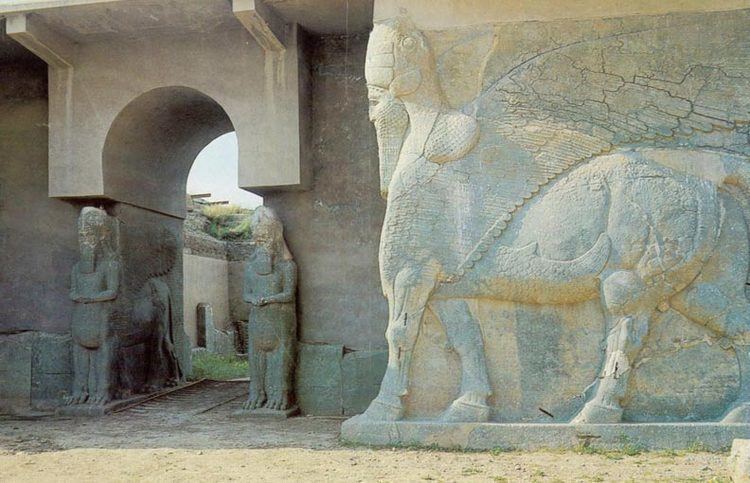 | ||
Weather 13°C, Wind E at 11 km/h, 66% Humidity | ||
Nimrud (/nɪmˈruːd/; Arabic: النمرود) is the Assyrian Neo-Aramaic name for the ancient Assyrian city of Kalhu (the Biblical Calah), located 30 kilometres (20 mi) south of the city of Mosul, and 5 kilometres (3 mi) south of the village of Selamiyah (Arabic: السلامية), in the Nineveh plains in northern Mesopotamia. It was a major Assyrian city between approximately 1350 BC and 610 BC. The city is located in a strategic position 10 kilometres (6 mi) north of the point that the river Tigris meets its tributary the Great Zab. The city covered an area of 360 hectares (890 acres). The ruins of the city were found within one kilometre (1,100 yd) of the modern-day Assyrian village of Noomanea in Nineveh Province, Iraq. This is some 30 kilometres (19 mi) southeast of Mosul.
Contents
- Foundation
- Capital of the Empire
- Ashurnasirpal II
- Shalmaneser III
- Later geographical writings
- Early writings and excavations
- Artworks
- Significant inscriptions
- Destruction
- Gallery
- References

Archaeological excavations at the site began in 1845, and were conducted at intervals between then and 1879, and then from 1949 onwards. Many important pieces were discovered, with most being moved to museums in Iraq and abroad. In 2013 the UK's Arts and Humanities Research Council funded the "Nimrud Project", directed by Eleanor Robson, whose aims were to write the history of the city in ancient and modern times, to identify and record the dispersal history of artefacts from Nimrud, distributed amongst at least 76 museums worldwide (including 36 in the United States and 13 in the United Kingdom).
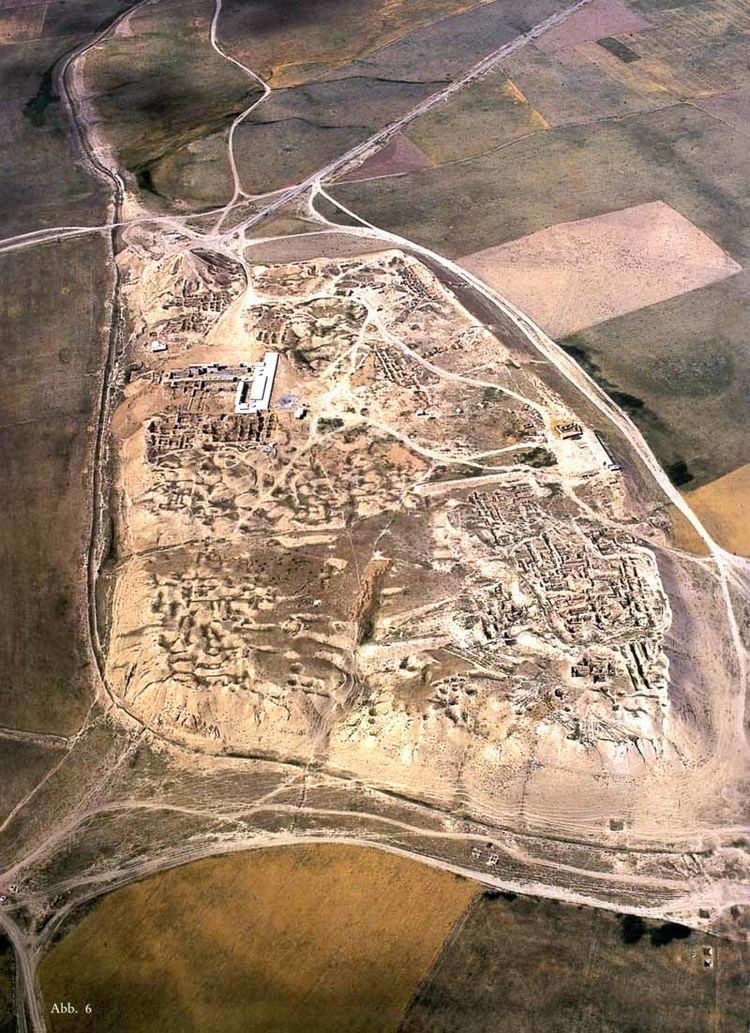
Archaeologists believe that the city was given the name Nimrud in modern times after the Biblical Nimrod, a legendary hunting hero. The city was identified as the Biblical city of Calah (Hebrew Kelah (כלח), Greek Khalakh (χαλαχ)), also written Kalhu, first referred to alongside Nimrod in Genesis 10, by Henry Rawlinson in 1850 on the basis of a possible interpretation of the city's cuneiform proper name as "Levekh".
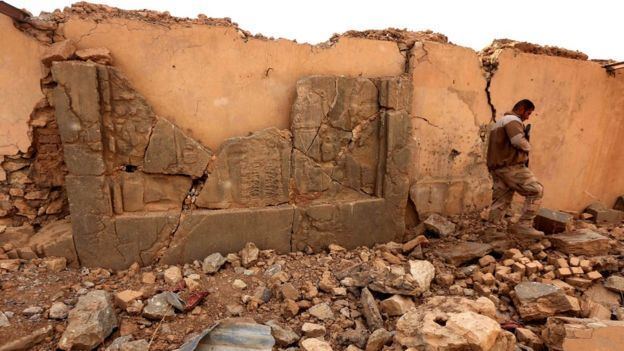
In 2015, the terrorist organization Islamic State of Iraq and the Levant (ISIL) announced its intention to destroy the site because of its "un-Islamic" Assyrian nature. In March 2015, the Iraqi government reported that ISIL had used bulldozers to destroy excavated remains of the city. A video released in the same month showed a lamassu (an Assyrian winged bull) statue in the city being attacked by a terrorist with a sledgehammer. Another video posted online by the group in April 2015 showed the site being destroyed by bulldozers and explosives.

Foundation
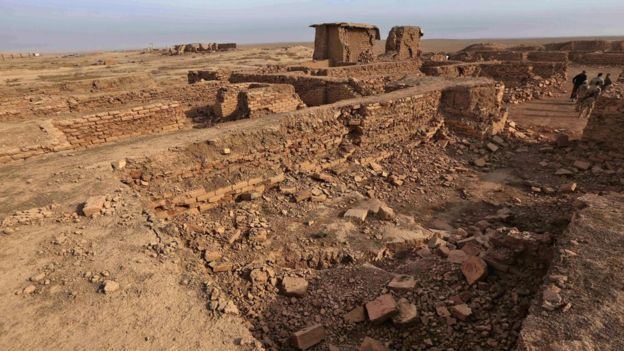
The Assyrian king Shalmaneser I (1274 BC–1245 BC) built up Kalhu (Nimrod) into a major city during the Middle Assyrian Empire (1365-1050 BC). However, the ancient city of Assur remained the capital of Assyria, as it had been since c. 3500 BC.
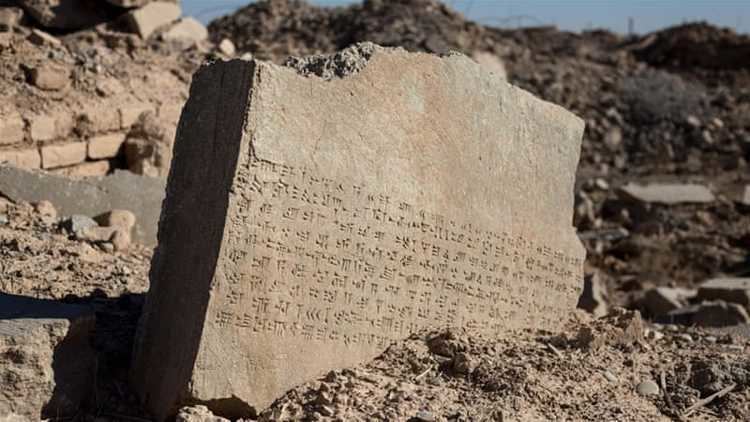
Psychologist Julian Jaynes believe that the Biblical figure Nimrod (of whom the far later Syriac and Arab name for the city was derived) was inspired by the deeds of the real king of Assyria Tukulti-Ninurta I (1244–1207 BC), the son of Shalmaneser I, and a powerful conqueror. Others believe the name derived from the Assyrian god Ninurta, who had a major cultic centre at Nimrud.
Capital of the Empire

The city gained fame when king Ashurnasirpal II (883-859 BC) of the Neo Assyrian Empire (911–605 BC) made it his capital at the expense of Assur. He built a large palace and temples in the city that had fallen into a degree of disrepair during the Dark Ages of the mid 11th to mid 10th centuries BC.
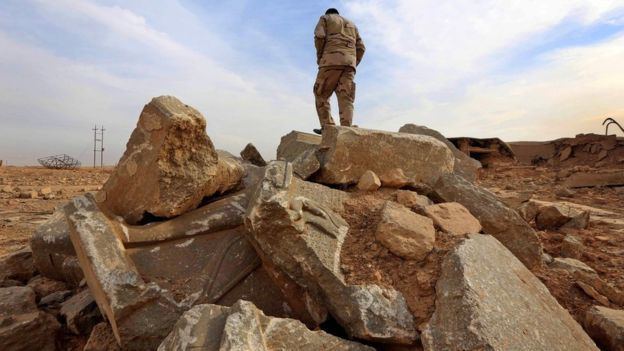
A grand opening ceremony with festivities and an opulent banquet in 879 BC is described in an inscribed stele discovered during archeological excavations. The city of king Ashurnasirpal II housed perhaps as many as 100,000 inhabitants, and contained botanic gardens and a zoo. His son, Shalmaneser III (858–824 BC), built the monument known as the Great Ziggurat, and an associated temple.

Nimrud remained the capital of the Assyrian Empire during the reigns of Shamshi-Adad V (822–811 BC), Adad-nirari III (810–782 BC), Queen Semiramis (810–806 BC), Adad-nirari III (806–782 BC), Shalmaneser IV (782–773 BC), Ashur-dan III (772–755 BC), Ashur-nirari V (754–746 BC), Tiglath-Pileser III (745–727 BC) and Shalmaneser V (726–723 BC). Tiglath-Pileser III in particular, conducted major building works in the city, as well as introducing Eastern Aramaic as the lingua franca of the empire, whose dialects still endure among the Christian Assyrians of the region today.
However, in 706 BC Sargon II (722–705 BC) moved the capital of the empire to Dur Sharrukin, and after his death, Sennacherib (705–681 BC) moved it to Nineveh. It remained a major city and a royal residence until the city was largely destroyed during the fall of the Assyrian Empire at the hands of an alliance of former subject peoples, including the Babylonians, Chaldeans, Medes, Persians, Scythians and Cimmerians (between 616 BC and 599 BC).
The Nineveh Province in which the ruins of Nimrud lie, is still the major center of Iraq's indigenous Assyrian population (now exclusively Eastern Aramaic-speaking Christians) to this day.
Ashurnasirpal II
King Ashurnasirpal II, who reigned from 883 to 859 BC, built a new capital at Nimrud. Thousands of men worked to build an 8-kilometre-long (5 mi) wall surrounding the city and a grand palace. There were many inscriptions carved into limestone including one that said: "The palace of cedar, cypress, juniper, boxwood, mulberry, pistachio wood, and tamarisk, for my royal dwelling and for my lordly pleasure for all time, I founded therein. Beasts of the mountains and of the seas, of white limestone and alabaster I fashioned and set them up on its gates." The inscriptions also described plunder stored at the palace: "Silver, gold, lead, copper and iron, the spoil of my hand from the lands which I had brought under my sway, in great quantities I took and placed therein." The inscriptions also described great feasts he had to celebrate his conquests. However his victims were horrified by his conquests. The text also said: "Many of the captives I have taken and burned in a fire. Many I took alive; from some I cut off their hands to the wrists, from others I cut off their noses, ears and fingers; I put out the eyes of many of the soldiers. I burned their young men, women and children to death." About a conquest in another vanquished city he wrote: "I flayed the nobles as many as rebelled; and [I] spread their skins out on the piles." These shock tactics brought success in 877 BCE, when after a march to the Mediterranean he announced "I cleaned my weapons in the deep sea and performed sheep-offerings to the gods."
Shalmaneser III
King Ashurnasirpal's son Shalmaneser III (858–823 BC) continued where his father had left off. He spent 31 years of his 35-year reign in war and conquest. After a battle near the Orontes River with a coalition of Aramean and Canaanite/Phoenician states he boasted:
At Nimrud he built a palace that far surpassed his father's. It was twice the size and it covered an area of about 5 hectares (12 acres) and included more than 200 rooms.
In 828 BC, his son rebelled against him and was joined by 27 other Assyrian cities including Nineveh and Ashur. This conflict lasted until 821 BC, 3 years after Shalmaneser's death, during the reign of Shamshi-Adad V (822–811 BC).
Later geographical writings
Ruins of a similarly located city named "Larissa" were described by Xenophon in his Anabasis in the 5th century BCE.
A similar locality was described in the Middle Ages by a number of Arabic geographers including Yaqut al-Hamawi, Abu'l-Fida and Ibn Sa'id al-Maghribi, using the name "Athur" near Selamiyah.
Early writings and excavations
The name Nimrud in connection with the site was first used in the writings of Carsten Niebuhr, who was in Mosul in March 1760.
The site was described in more detail by the British traveler Claudius James Rich in 1820, shortly before his death. Rich identified the site with the city of Larissa in Xenophon, and noted that the locals "generally believe this to have been Nimrod's own city; and one or two of the better informed with whom I conversed at Mousul said it was Al Athur or Ashur, from which the whole country was denominated."
Genesis 10 states "From that land he went to Assyria, where he built Nineveh, the city Rehoboth-Ir, Calah and Resen". The identification of each these four Biblical names with the known Assyrian ruins was the cause of significant debate amongst Assyriologists in the mid-nineteenth century. The site of Nimrud was visited by William Francis Ainsworth in 1837 and by James Phillips Fletcher in 1843. Ainsworth, like Rich, identified the site with Larissa (Λάρισσα) of Xenophon's Anabasis, concluding that Nimrud was the Biblical Resen on the basis of Bochart's identification of Larissa with Resen on etymological grounds. Fletcher instead identified the site with Rehoboth on the basis that the city of Birtha described by Ptolemy and Ammianus Marcellinus has the same etymological meaning as Rehoboth in Hebrew.
Excavations at Nimrud were conducted by Austen Henry Layard, working from 1845 to 1847 and from 1849 until 1851. Prior to 1850, Layard believed that the site of "Nimroud" was part of the wider region of "Nineveh" (the debate as to which excavation site represented the city of Nineveh had yet to be resolved), which also included the two mounds today identified as Nineveh-proper, and his excavation publications were thus labeled. Henry Rawlinson identified the city with the Biblical Calah on the basis of a cuneiform reading of "Levekh" which he connected to the city following Ainsworth and Rich's connection of Xenophon's Larissa to the site.
Following Layard's departure, the work was handed over to Hormuzd Rassam, himself an Assyrian, in 1853-54 and then W. K. Loftus in 1854-55.
After George Smith briefly worked the site in 1873 and Rassam returned there from 1877 to 1879, Nimrud was left untouched for almost 60 years. A British School of Archaeology in Iraq team led by Max Mallowan resumed digging at Nimrud in 1949. The work continued until 1963 with David Oates becoming director in 1958 followed by Julian Orchard in 1963.
Subsequent work was by the Directorate of Antiquities of the Republic of Iraq (1956, 1959–60, 1969–78 and 1982–92), Janusz Meuzynski (1974–76), Paolo Fiorina (1987–89) with the Centro Ricerche Archeologiche e Scavi di Torino who concentrated mainly on Fort Shalmaneser, and John Curtis (1989). In 1974 to his untimely death in 1976 Janusz Meuszynski, the director of the Polish Center for Mediterranean Archaeology project, with the permission of the Iraqi excavation team, had the whole site documented on film—in slide film and black-and-white print film. Every relief that remained in situ, as well as the fallen, broken pieces that were distributed in the rooms across the site were photographed. Meuszynski also arranged with the architect of his project, Richard P. Sobolewski, to survey the site and record it in plan and in elevation.
Excavations revealed remarkable bas-reliefs, ivories, and sculptures. A statue of Ashurnasirpal II was found in an excellent state of preservation, as were colossal winged man-headed lions weighing 10 short tons (9.1 t) to 30 short tons (27 t) each guarding the palace entrance. The large number of inscriptions dealing with king Ashurnasirpal II provide more details about him and his reign than are known for any other ruler of this epoch. The palaces of Ashurnasirpal II, Shalmaneser III, and Tiglath-Pileser III have been located. Portions of the site have been also been identified as temples to Ninurta and Enlil, a building assigned to Nabu, the god of writing and the arts, and as extensive fortifications.
Artworks
Nimrud has been one of the main sources of Assyrian sculpture, including the famous palace reliefs. Layard discovered more than half a dozen pairs of colossal guardian figures guarding palace entrances and doorways. These are lamassu, statues with a male human head, the body of a lion or bull, and wings. They have heads carved in the round, but the body at the side is in relief. They weigh up to 27 tonnes (30 short tons). In 1847 Layard brought two of the colossi weighing 9 tonnes (10 short tons) each including one lion and one bull to London. After 18 months and several near disasters he succeeded in bringing them to the British Museum. This involved loading them onto a wheeled cart. They were lowered with a complex system of pulleys and levers operated by dozens of men. The cart was towed by 300 men. He initially tried to hook up the cart to a team of buffalo and have them haul it. However the buffalo refused to move. Then they were loaded onto a barge which required 600 goatskins and sheepskins to keep it afloat. After arriving in London a ramp was built to haul them up the steps and into the museum on rollers.
Additional 27-tonne (30-short-ton) colossi were transported to Paris from Khorsabad by Paul Emile Botta in 1853. In 1928 Edward Chiera also transported a 36-tonne (40-short-ton) colossus from Khorsabad to Chicago. The Metropolitan Museum of Art in New York has another pair.
The Statue of Ashurnasirpal II, Stela of Shamshi-Adad V and Stela of Ashurnasirpal II are large sculptures with portraits of these monarchs, all secured for the British Museum by Layard and the British archaeologist Hormuzd Rassam. Also in the British Museum is the famous Black Obelisk of Shalmaneser III ,discovered by Layard in 1846. This stands six-and-a-half-feet tall and commemorates with inscriptions and 24 relief panels the king's victorious campaigns of 859–824 BC. It is shaped like a temple tower at the top, ending in three steps.
Series of the distinctive Assyrian shallow reliefs were removed from the palaces and sections are now found in several museums (see gallery below), in particular the British Museum. These show scenes of hunting, warfare, ritual and processions. The Nimrud Ivories are a large group of ivory carvings, probably mostly originally decorating furniture and other objects, that had been brought to Nimrud from several parts of the ancient Near East, and were in a palace storeroom and other locations. These are mainly in the British Museum and the National Museum of Iraq, as well as other museums. Another storeroom held the Nimrud Bowls, about 120 large bronze bowls or plates, also imported.
The "Treasure of Nimrud" unearthed in these excavations is a collection of 613 pieces of gold jewelry and precious stones. It has survived the confusions and looting after the invasion of Iraq in 2003 in a bank vault, where it had been put away for 12 years and was "rediscovered" on June 5, 2003.
Significant inscriptions
One panel of the Black Obelisk of Shalmaneser III has an inscription which includes the name mIa-ú-a mar mHu-um-ri-i. Whilst Rawlinson originally translated this in 1850 as "Yahua, son of Hubiri", a year later reverend Edward Hincks, suggested it refers to king Jehu of Israel. Whilst other interpretations exist, the obelisk is widely viewed by biblical archaeologists as therefore including the earliest known dedication of an Israelite.
A number of other artifacts considered important to Biblical history were excavated from the site, such as the Nimrud Tablet K.3751 and the Nimrud Slab. The bilingual Assyrian lion weights were important to scholarly deduction of the history of the alphabet.
Destruction
Nimrud's various monuments had faced threats from exposure to the harsh elements of the Iraqi climate. Lack of proper protective roofing meant that the ancient reliefs at the site were susceptible to erosion from wind-blown sand and strong seasonal rains.
The greatest threat to Nimrud is from the Islamic State of Iraq and the Levant (ISIL), which occupied that area in mid-2014. ISIL destroyed other holy sites, including the Mosque of the Prophet Jonah in Mosul. In early 2015, they announced their intention to destroy many ancient artifacts, because they are graven images or are otherwise un-Islamic, and destroyed thousands of books and manuscripts in Mosul's libraries. In February 2015, ISIL destroyed Akkadian monuments in the Mosul Museum, and on March 5, 2015, Iraq announced that ISIL militants had bulldozed Nimrud and its archaeological site on the basis that they were blasphemous, which one attacker filmed declaring, "These ruins that are behind me, they are idols and statues that people in the past used to worship instead of Allah. The Prophet Muhammed took down idols with his bare hands when he went into Mecca. We were ordered by our prophet to take down idols and destroy them, and the companions of the prophet did this after this time, when they conquered countries.” ISIL declared an intention to destroy the restored city gates in Nineveh. ISIL went on to do demolition work at the later Parthian ruined city of Hatra. On April 12 2015, an on-line militant video purportedly showed ISIL militants hammering, bulldozing and ultimately using explosive to blow up parts of Nimrud. Irina Bokova, the director general of UNESCO, stated "deliberate destruction of cultural heritage constitutes a war crime". The president of the Syriac League in Lebanon compared the losses at the site to the destruction of culture by the Mongol Empire. In November 2016, aerial photographs showed the systematic leveling of the Ziggurat by heavy machines. On 13 November 2016, the Iraqi Army recaptured the city from ISIL. The Joint Operations Command stated that it had raised the Iraqi flag above its buildings and also captured the Assyrian village of Numaniya, on the edge of the town.
